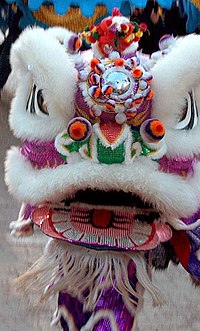Lion dance (simplified Chinese: 舞狮; traditional Chinese: 舞獅; pinyin: wǔshī) is a form of traditional dance in Chinese culture and other Asian countries in which performers mimic a lion's movements in a lion costume. The lion dance is usually performed during the Chinese New Year and other Chinese traditional, cultural and religious festivals. It may also be performed at important occasions such as business opening events, special celebrations or wedding ceremonies, or may be used to honour special guests by the Chinese communities.
The Chinese lion dance is sometimes mistakenly referred to as dragon dance. An easy way to tell the difference is that a lion is normally operated by just two dancers, while a dragon is longer and needs many people. Also, in a lion dance, the performers' faces are only seen occasionally, since they are inside the lion. In a dragon dance, the performers' faces can be easily seen since the dragon is held on poles. Chinese lion dance fundamental movements can be found in most Chinese martial arts.
There are two main forms of the Chinese lion dance, the Northern Lion and the Southern Lion. Both forms are commonly found in China, but around the world especially in South East Asia, the Southern Lion predominates as it was spread by the Chinese diaspora communities who are historically mostly of Southern Chinese origin. Versions of the lion dance are also found in Japan, Korea, Tibet and Vietnam. Another form of lion dance exists in Indonesian culture, but it may be of a different tradition and may be referred to as Singa Barong.
There has been an old tradition in China of dancers wearing masks to resemble animals or mythical beasts since antiquity, and performances described in ancient texts such as Shujing where wild beasts and phoenix danced may have been masked dances. In Qin Dynasty sources, dancers performing exorcism rituals were described as wearing bearskin mask, and it was also mentioned in Han Dynasty texts that "mime people" (象人) performed as fish, dragons, and phoenixes. However, lion is not native to China, and the Lion Dance therefore has been suggested to have originated outside of China from countries such as India or Persia, and introduced via Cental Asia. According to ethnomusicologist Laurence Picken, the Chinese word for lion itself, shi (獅, written as 師 in the early periods), may have been derived from the Persian word šer. The earliest use of the word shizi meaning lion first appeared in Han Dynasty texts and had strong association with Central Asia (an even earlier but obsolete term for lion was suanni (狻麑 or 狻猊)), and lions were presented to the Han court by emissaries from Central Asia and the Parthian Empire. Detailed descriptions of Lion Dance appeared during the Tang Dynasty and it was already recognized by writers and poets then as a foreign dance, however, Lion dance may have been recorded in China as early as the third century AD where "lion acts" were referred to by a Three Kingdoms scholar Meng Kang (孟康) in a commentary on Hanshu. In the early periods it had association with Buddhism: it was recorded in a Northern Wei text, Description of Buddhist Temples in Luoyang (洛陽伽藍記), that a parade for a statue of Buddha of a temple was led by a lion to drive away evil spirits.
...
Wikipedia

